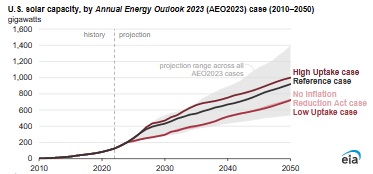
Data source: U.S. Energy Information Administration, Annual Energy Outlook 2023
Note: Does not include off-grid photovoltaics (PV)
In 2050, we project that total U.S. solar capacity, which includes both utility-scale solar and rooftop solar in the commercial and residential sectors, could range from 532 gigawatts (GW) to 1,399 GW. In our Annual Energy Outlook 2023 (AEO2023), we present 16 scenarios, or cases, that project long-term energy trends in the United States through 2050.
Our Issues in Focus: Inflation Reduction Act Cases in the AEO2023 focuses on 4 of the 16 cases that vary the amount of tax credits that clean energy technologies receive under the 2022 Inflation Reduction Act (IRA). In one case without the IRA, solar capacity reaches 726 GW by 2050. Three separate cases that assume various uptake levels of the tax credits project up to 274 GW more solar capacity by 2050 than there would be without the law.
Under the IRA, qualifying clean energy projects can receive additional bonus tax credits stacked on top of a base tax credit value if they satisfy certain requirements. A qualifying solar project can choose either a credit for the investment in clean energy, called an investment tax credit (ITC), or a credit for producing or selling clean energy, called a production tax credit (PTC).
For instance, we assume in the AEO2023 Reference case that owners of solar projects in the electric power sector prefer the PTC, which has a base value of $5 per megawatthour (MWh) for the first 10 years of electricity sales. The value is five times higher for projects that receive a bonus credit for meeting labor requirements. Other bonus credits raise the credit value even higher if projects are built domestically or are located in the IRA's definition of energy communities.
These three cases examine the IRA while holding other input assumptions constant to their AEO2023 Reference case values. The AEO2023 Reference case, which serves as a baseline, or benchmark, reflects laws and regulations adopted through mid-November 2022, including the IRA. The other three cases are the:
- High Uptake case, which assumes, where applicable, that qualified projects receive the maximum bonus tax credits
- Low Uptake case, which assumes most qualified projects only receive the base tax credit
- No IRA case, which excludes energy-related IRA provisions
In the Reference case, U.S. solar capacity, including rooftop solar, reaches 920 GW in 2050, about 194 GW more than in the No IRA case. Solar capacity still grows in the No IRA case, in part, because of declining capital costs. U.S. solar capacity grows the most when we apply more bonus credits. In the High Uptake case, where we apply the maximum bonus credits for grid-scale solar, U.S. solar capacity reaches just under 1,000 GW. The Low Uptake case is similar to the No IRA case and results in just over 720 GW of solar.
Our Issues in Focus: Inflation Reduction Act Cases in the AEO2023 has detailed data and additional information on how our IRA tax credit assumptions differ among the four cases. For solar PV projects in the electric power sector, the Low Uptake case applies only the base tax credit. Our Reference case applies the base credit and prevailing wage and apprenticeship bonus credit. The High Uptake case applies the base tax credit as well as the prevailing wage and apprenticeship, domestic content, and the energy communities bonus credits.
In the commercial sector, we assume solar PV projects receive the base credit in the Low Uptake and Reference cases. In the High Uptake case, we assume projects also receive the domestic content bonus credit. For residential solar, qualified projects do not receive bonus credits under the IRA's residential clean energy credit provision. Therefore, we assume residential solar projects receive a 30% credit in all three cases (Reference, Low Uptake, and High Uptake) that phases down to 0% in 2035.









